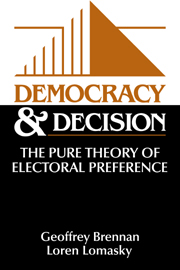Book contents
- Frontmatter
- Contents
- Preface
- 1 Ethics, politics, and public choice
- 2 The logic of electoral choice
- 3 The nature of expressive returns
- 4 The analytics of decisiveness
- 5 The theory of electoral outcomes: implications for public choice theory
- 6 From anecdote to analysis
- 7 Interpreting the numbers
- 8 Consensus, efficiency, and contractarian justification
- 9 Paternalism, self-paternalism, and the state
- 10 Toward a democratic morality
- 11 Constitutional implications
- Bibliography
- Index
5 - The theory of electoral outcomes: implications for public choice theory
Published online by Cambridge University Press: 05 June 2012
- Frontmatter
- Contents
- Preface
- 1 Ethics, politics, and public choice
- 2 The logic of electoral choice
- 3 The nature of expressive returns
- 4 The analytics of decisiveness
- 5 The theory of electoral outcomes: implications for public choice theory
- 6 From anecdote to analysis
- 7 Interpreting the numbers
- 8 Consensus, efficiency, and contractarian justification
- 9 Paternalism, self-paternalism, and the state
- 10 Toward a democratic morality
- 11 Constitutional implications
- Bibliography
- Index
Summary
The term “free-trade,” like “virginity,” refers to one condition only, whereas “protection” covers a multitude, as does “sin.” This book is an investigation into the morphology of the sin of protection, not into conditions of a fall from grace.
J. J.|Pincus, Pressure Groups and Politics in Antebellum TariffsIntroduction
In the preceding three chapters, we have attempted to spell out our theory of electoral preference, derived from the standard axioms of rational actor theory. This theory is one part of a general rational actor theory of politics – and an important and much neglected part – but it is not the whole story. To develop a theory of electoral politics out of a theory of electoral preference requires us to connect electoral outcomes to voter preference in some way. It is necessary, in other words, to show how the interactions of individual voters operating within the institutional structure of electoral political process serve to generate political outcomes. In fact, orthodox public choice models have focused almost exclusively on this latter issue: In technical terms they have been primarily concerned with the properties of majority rule as an aggregation device. What these models have shown is that the connection between electoral outcomes and (revealed) voter preferences is, under the most plausible assumptions, complex and potentially perverse – perverse in the sense that majority rule can lead to electoral outcomes that no voter would desire, even if revealed electoral preferences were identical with the voters' true preferences over electoral outcomes.
- Type
- Chapter
- Information
- Democracy and DecisionThe Pure Theory of Electoral Preference, pp. 74 - 89Publisher: Cambridge University PressPrint publication year: 1993



